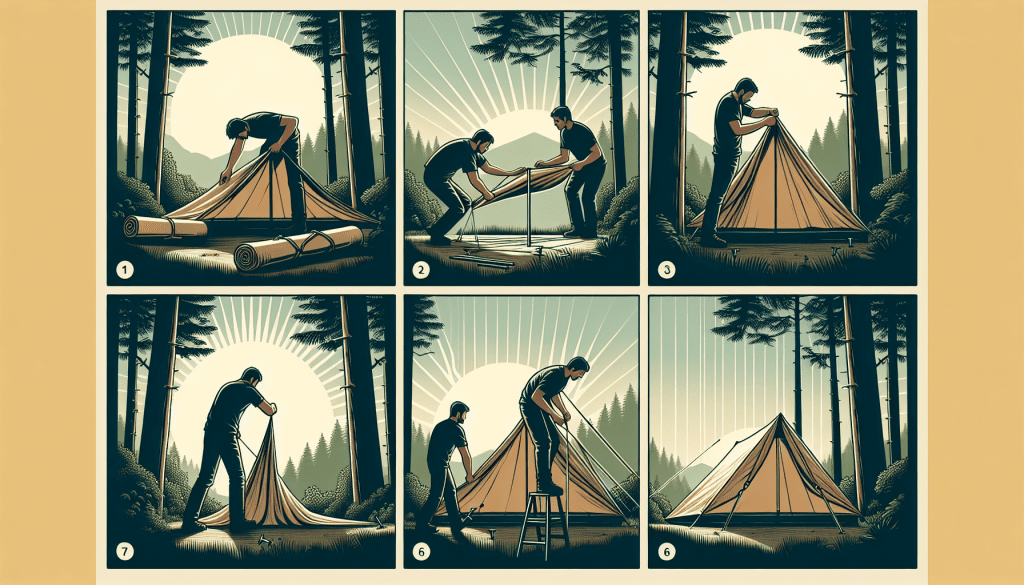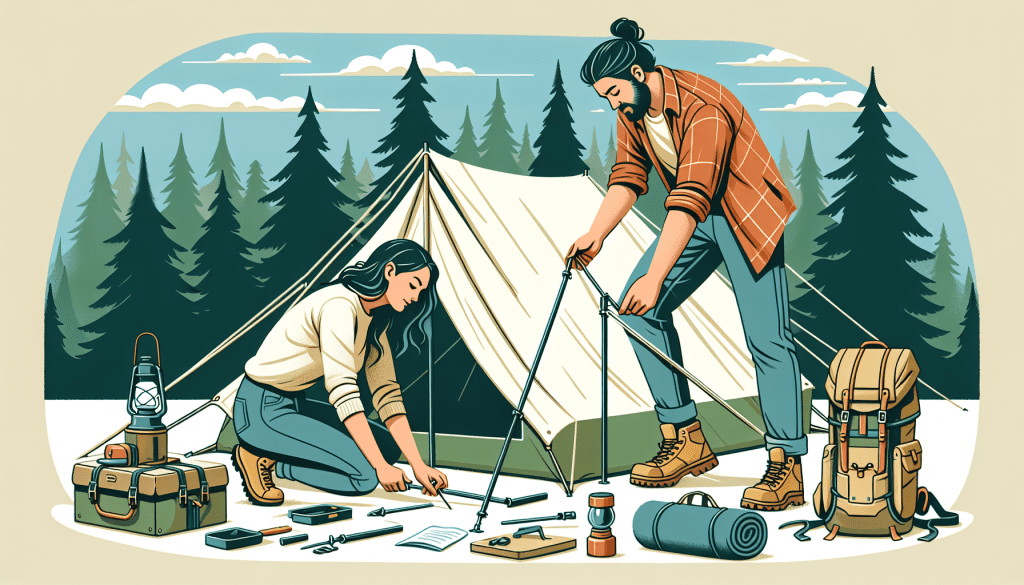Having to set up a tent can be a fun and exciting activity, whether you’re embarking on a camping adventure or setting up a temporary shelter for an outdoor event. However, without the right knowledge and techniques, it can quickly turn into a frustrating experience. In this article, you will discover the best practices to set up a tent, from choosing the perfect location to securing it properly, ensuring a hassle-free and enjoyable outdoor experience. So, grab your tent and let’s get started!
Choosing the Right Tent
Consider the Tent Size
When choosing the right tent for your camping adventure, it is important to consider the tent size that will best accommodate you and your fellow campers. Think about the number of people that will be using the tent and whether you will need additional space for storing gear. It’s always a good idea to go for a tent that can comfortably accommodate one or two people more than the actual number of campers to ensure you have enough room to move around and store your belongings.
Look for Durability
Durability is another crucial factor to consider when selecting a tent. You want a tent that can withstand various weather conditions and keep you protected. Look for tents made with high-quality materials such as ripstop nylon or polyester. These materials are known for their strength and resistance to tear. Additionally, check the tent’s waterproof rating to ensure it will keep you dry during those unexpected rain showers.
Consider the Tent Shape
Tent shape is often a matter of personal preference, but it is worth considering the different options available. Dome-shaped tents are popular due to their stable structure and spacious interior. They also offer good wind resistance. Cabin-style tents, on the other hand, provide more vertical walls, allowing for increased headroom and space. Tunnel-shaped tents are great for lightweight backpacking adventures as they are easy to set up and offer excellent ventilation. Consider your camping needs and preferences to choose the tent shape that suits you best.
Selecting the Right Campsite
Find a Level Ground
Finding a level ground for your tent is essential for a comfortable sleeping experience. Look for a spot that is flat and free from any slopes or uneven terrain. Sleeping on an incline can lead to discomfort and difficulty staying in your sleeping bag throughout the night. Take the time to scout your campsite and find the most level area available.
Consider Shade and Wind Direction
When selecting a campsite, it is important to consider the surrounding environment. Look for shade, especially if you are camping in a hot climate. Shade can provide relief from the sun during the day and help keep your tent cooler. Additionally, pay attention to the wind direction. To set up a tent in a sheltered area, such as behind a natural windbreak like trees or rocks, often provides added protection and prevent your tent from rocking in strong gusts.
Check for Potential Hazards
Before setting up camp, take a moment to scan the area for potential hazards. Look out for dead tree branches that could fall, ant nests that could cause problems, or animal tracks that indicate a frequented path. It’s better to not set up a tent directly under trees that may have dead or weak branches, as they pose a safety risk. Being mindful of potential hazards ensures a safe and enjoyable camping experience.

Gathering the Necessary Tools
Tent
The tent itself is, of course, the most essential tool for camping. Choose a tent that suits your needs in terms of size, durability, and shape, as discussed earlier. Consider factors such as ease of setup and the type of camping you will be doing, whether it’s backpacking or car camping.
Groundsheet or Footprint
A groundsheet or footprint is a protective layer that goes under your tent. It acts as a barrier between the tent floor and the ground, preventing moisture and sharp objects from damaging the tent. It also provides an extra layer of insulation. Make sure to choose a groundsheet or footprint that matches the size and shape of your tent.
Tent Stakes
Tent stakes are used to secure the tent to the ground and provide stability. Look for sturdy and durable stakes that can withstand different ground conditions. Consider the length and design of the stakes to ensure they will securely anchor the tent. Carry extra stakes in case any get lost or damaged during your camping trip.
Tent Poles
Tent poles are essential for creating the structure and support of your tent. They give the tent its shape and ensure it remains stable. Choose tent poles made from lightweight yet durable materials such as aluminum or fiberglass. Consider whether you prefer poles that attach to the tent via clips or sleeves, as this can affect the ease of setup.
Guy Ropes
Guy ropes are used to increase the stability of your tent and provide extra support during windy conditions. They attach to the tent and are anchored into the ground. Look for guy ropes that are strong and adjustable. Reflective ropes or ones with built-in tensioners are particularly helpful for visibility and easy adjustment.
Rubber Mallet or Hammer
A rubber mallet or hammer is necessary for driving in the tent stakes. This tool allows you to exert enough force without damaging the stakes or the ground. A rubber mallet is preferred over a regular hammer as it reduces the risk of damage and noise.
Headlamp or Flashlight
A headlamp or flashlight is an essential tool when you set up a tent and camp in low-light conditions. It provides hands-free illumination, allowing you to navigate the campsite and set up a tent with ease. Choose a headlamp or flashlight with adjustable brightness settings and consider bringing extra batteries or a portable charger.
Preparing the Campsite
Clear the Campsite to Set Up a Tent
Before you set up a tent, it’s important to clear the campsite of any debris, rocks, or sticks. Clearing the area provides a clean and comfortable space for your tent and minimizes the risk of damage to the tent floor. It also helps to create a tidy camping environment.
Remove Rocks, Sticks, and Other Debris
Remove any rocks, sticks, or other debris from the area where you plan to set up a tent. These objects could cause discomfort when lying down or puncture the tent floor. Take the time to carefully inspect the ground and remove any potential hazards.
Make Sure the Ground is Smooth
After clearing the campsite of debris, ensure the ground is smooth. Remove any small rocks or roots that could cause discomfort while you sleep. Smoothing out the ground will also help prevent any uneven pressure on the tent floor, enhancing your sleeping experience.
Avoid Camping Near Water Sources
While the soothing sound of a nearby stream may sound appealing, it is generally recommended to avoid the urge to set up a tent too close to water sources. Water sources may attract insects and wildlife, increasing the chances of encounters and potential hazards. Additionally, unexpected rain or rising water levels can pose a risk if the campsite is too close to a water source. Choose a safe distance away from water to ensure a peaceful and trouble-free camping experience.
Laying Out the Groundsheet or Footprint
Choose the Correct Positioning
Before laying out the groundsheet or footprint, ensure you have chosen the correct positioning to set up a tent. Consider factors such as wind direction and the campsite layout. Align the groundsheet or footprint appropriately to ensure it fits within the desired camping area.
Smooth Out the Groundsheet
Once you have placed the groundsheet or footprint in the correct position, smooth it out to remove any air pockets or wrinkles. This will prevent discomfort or damage to the tent floor and ensure a level surface to set up a tent.
Secure the Groundsheet to the Ground
To prevent the groundsheet from moving or being blown away, secure it to the ground using stakes or weights. This will help keep the groundsheet in place and provide a stable foundation to set up a tent. Ensure the groundsheet is taut and securely anchored to avoid any tripping hazards.
Assembling the Tent
Unpack the Tent
Begin assembling your tent by unpacking all the components from its storage bag. Lay them out in an organized manner to make the setup process smoother. Ensure that all parts, including the rainfly and guy lines, are accounted for.
Lay Out the Tent Components
Take each component of the tent, such as the tent body, rainfly, and tent poles, and lay them out in the designated areas on the groundsheet or footprint. Familiarize yourself with each component and its purpose to make assembly easier.
Attach the Tent Poles
Starting with the tent poles, locate the corresponding pole sleeves or clips on the tent body. Gently slide the tent poles through the sleeves or attach them to the clips. Make sure the poles fit securely and are properly aligned.
Raise the Tent
Once all the tent poles are attached, carefully lift the tent body off the ground and raise it to its full height. Work your way around the tent, adjusting the poles as necessary to ensure the tent stands upright and is stable.
Insert the Tent Stakes
With the tent body standing, insert the tent stakes through the designated loops or rings located at the tent’s base. Push the stakes firmly into the ground at a 45-degree angle to maximize their holding power. Start with the corners and then move on to the sides and center, ensuring the tent is evenly and securely anchored.
Attach the Rainfly (if applicable)
If your tent comes with a rainfly, now is the time to attach it. Some tents have a rainfly that is permanently attached, while others may require you to secure it separately. Carefully align the rainfly to match the orientation of the tent body and attach it according to the manufacturer’s instructions. The rainfly provides an additional layer of protection against rain and wind, ensuring a dry and comfortable camping experience.
Securing the Tent to the Ground
Stake Down the Tent Corners
To secure the tent further, stake down the corners of the tent body. Insert additional stakes at the corners of the tent, ensuring they are firmly anchored to the ground. This will provide added stability and prevent the tent from shifting or collapsing in windy conditions.
Use Guy Ropes to Strengthen Stability
Attach guy ropes to the designated loops or rings on the tent and stake them down at a 45-degree angle away from the tent. Tension the guy ropes to create an outward force, increasing the tent’s stability and resistance to strong winds. Adjust the tension as needed to ensure the tent is taut and secure.
Tighten and Adjust the Tent as Necessary
After staking down the tent and attaching the guy ropes, walk around the tent and carefully inspect it for any slack or loose sections. Tighten any loose areas by adjusting the guy ropes or tent stakes. Proper tension ensures the tent remains secure and reduces the risk of damage during adverse weather conditions.
Ensure Proper Tension on Guy Ropes and Stakes
Maintaining the proper tension on both the guy ropes and tent stakes is key to the tent’s stability. Ensure the guy ropes are taught but not overly tight to allow for slight movement in response to wind. Check the tent stakes regularly, tightening them if necessary, to ensure they remain firmly anchored in the ground.
Organizing the Interior
Designate Sleeping and Living Areas
When organizing the interior of your tent, consider designating specific areas for sleeping and living. This will help maximize space and create a comfortable living environment. Place your sleeping bags or air mattresses in one section of the tent and set up camp furniture, such as chairs or a table, in another area.
Arrange Sleeping Equipment
Arrange your sleeping equipment in a way that maximizes comfort and accessibility. Ensure everyone has enough space to sleep and move around without feeling cramped. Keep personal items close by, such as books, smartphones, or a flashlight, for easy access during the night.
Set Up Camp Furniture
Set up camp furniture to create comfortable seating and a designated area for dining or relaxation. Arrange chairs and tables to create a communal space where you can gather and enjoy meals or engage in social activities with fellow campers.
Consider Storage Solutions
Utilize storage solutions such as hanging organizers, storage bins, or gear lofts to keep your belongings organized and easily accessible. Create designated areas for items such as clothes, shoes, toiletries, and cooking supplies. This will help prevent clutter and ensure a tidy living space inside the tent.

Proper Tent Maintenance
Regular Cleaning and Drying
Proper maintenance of your tent is essential to prolong its lifespan and ensure it remains in good condition. After each camping trip, thoroughly clean the tent by wiping off any dirt or debris. Use a mild soap and water solution to gently clean any stains or marks. Allow the tent to dry completely before packing it away to prevent mold or mildew growth.
Inspect and Repair Any Damage
Regularly inspect your tent for any signs of damage, such as tears, holes, or bent poles. Repair any minor damage promptly using a tent repair kit or patch tape. Replace any damaged or severely worn components, such as tent stakes or guy ropes, to maintain the tent’s structural integrity.
Store the Tent Properly
Properly storing your tent between camping trips is crucial for its longevity. Clean and dry the tent thoroughly, as mentioned earlier. Fold the tent neatly and store it in a dry and cool area, away from direct sunlight. Avoid storing the tent in a tightly compressed state, as this can damage the fabric or cause creases that are difficult to remove. Using a storage bag or container specifically designed for tents can help protect it from dust and damage.
Safety Considerations
Ensure Proper Ventilation
Proper ventilation is essential for maintaining a healthy and comfortable environment inside the tent. Ensure all windows and vents are open, allowing fresh air to circulate and prevent condensation buildup. However, if the weather is inclement, it is important to strike a balance between ventilation and keeping the tent sealed to remain dry and warm.
Keep Combustible Materials Away
To ensure fire safety, keep combustible materials away from the tent. This includes camping stoves, lanterns, and open fires. Maintain a safe distance from flammable objects to reduce the risk of accidental fires. Always use caution when cooking or handling any open flames inside or near the tent.
Secure Tent Flaps and Zippers
Before turning in for the night, make sure all tent flaps and zippers are securely closed and fastened. This will prevent insects, bugs, or small animals from entering the tent. It will also help maintain a comfortable temperature inside the tent and reduce the chances of rainwater seeping in during a sudden downpour.
Practice Fire Safety
When camping, it is important to practice proper fire safety. Avoid building open fires directly outside the tent, as this poses a risk of sparks or embers igniting the tent fabric. Instead, use designated fire pits or cooking areas and always supervise fires. Be sure to fully extinguish fires before leaving the campsite or going to bed, ensuring embers are cold to the touch and no longer smoldering.
By following these practices in order to set up a tent, you can ensure a safe, comfortable, and enjoyable camping experience. Take the time to choose the right tent, select a suitable campsite, gather the necessary tools, and properly maintain your tent. With careful planning and attention to detail, your camping adventure is sure to be a memorable one. Happy camping!


